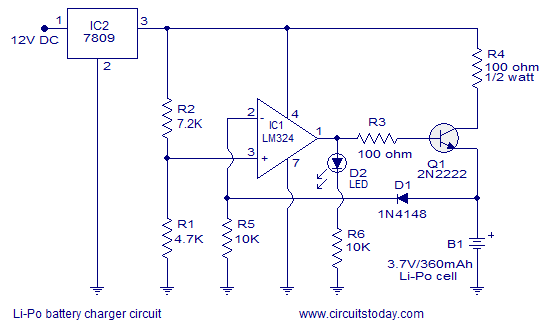Li-Po battery or Lithium-Polymer battery is a rechargeable battery
Li-Po battery or Lithium-Polymer battery is a rechargeable battery based on the Lithium-ion technology enclosed in a flexible pouch. This soft, flexible pouch makes them very light with a compromise in mechanical strength. Li-Po batteries are widely used in applications where weight is a critical factor. The common applications are radio controlled model flight, RC toys, hand held devices etc.
The Lithium Polymer battery is evolved from the Lithium Metal Batteries.The main difference is that instead of using Lithium salt electrolyte binded in organic solvents like Ethylene carbonate, Di Methyl Carbonate Di Ethyl Carbonate , Li-Po batteries use polymer electrolytes like Poly Ethylene Oxide, Poly Methyl Methacrylate, Poly Acrilonitrile etc. The output voltage of Li-Po battery depends up on the technology used behind it. It is 2.7-3.0 V (discharged) to 4.20-4.35 V( charged) for cells based on Lithium Metal Oxides and it is 1.8-2.0 V (discharged) to 3.6-3.8 V (charged) for cells based on Lithium Iron Phosphate. The charging current is usually 1/5 of the mAH rating of the battery.
Like other Lithium batteries the Li-Po batteries are also prone to problems related with over charging, deep discharging, over temperature, short circuit etc. Any of these problem may result in permanent damage to the battery or even explosion. In order to avoid such problems, great care must be given while designing LiPo battery charger circuits.
Here we are discussing about a LiPo battery charger that can charge a 3.7V/360mAh cell. The charging voltage is limited to 4 volts for safety and the charging current is limited to 63mA. The circuit diagram of LiPo battery charger is shown below.
Circuit diagram.

Circuit diagram of the LiPo battery charger is shown above. The heart of the circuit is an LM324 opamp. LM324 is a general purpose single supply quad opamp. You can use any single supply opamp in its place. I used LM324 because it was the only single supply opamp with me at that time. TL071, TL072 etc are other options. The LM324 is wired as a comparator here. The reference voltage is applied to the non-inverting input and it is set using resistors R1 and R2. The reference voltage here is 3.5V. It is obtained using the equation Vref=(9/(R1+R2))*(R1). The positive terminal of the battery is connected to the inverting input of the opamp through diode D1. R5 is just a pull down resistor.
When ever the battery voltage is above 4 volts the voltage fed back to the inverting input will be higher than 3.5 voltas. That is 4V-D1 drop =3.5V. The output of the opamp swings to ground and transistor Q1 will be switched OFF. This isolates the battery from the charging voltage and the battery remains safe. When the battery voltage is below 4V, the voltage fed back to the inverting input will be lower than 3.5V and the output of the opamp swings to positive saturation. This makes the transistor ON and the battery starts charging. Resistor R4 limits the charging current of the battery to 60 mA. The governing equation is (Vcc-VcesatQ1-Vb)/R4=Ib. Where Vcc is the supply voltage, VcesatQ1 is the collector-emitter voltage of Q1 during saturation, Vb is the battery voltage when discharged, R4 is the current limiting resistor and Ib is the charging current. When substituted by values it is (9V-0.2V-2.7V)/100 ohm=61mA.
LED D2 is just an indicator.It glows the the battery is charging and extinguishes when the battery is fully charged. Voltage regualtor IC 7809 is used for producing steady 9V from the 12V supply.
This article is from Allicdata Electronics. Reprinted need to indicate the source.

